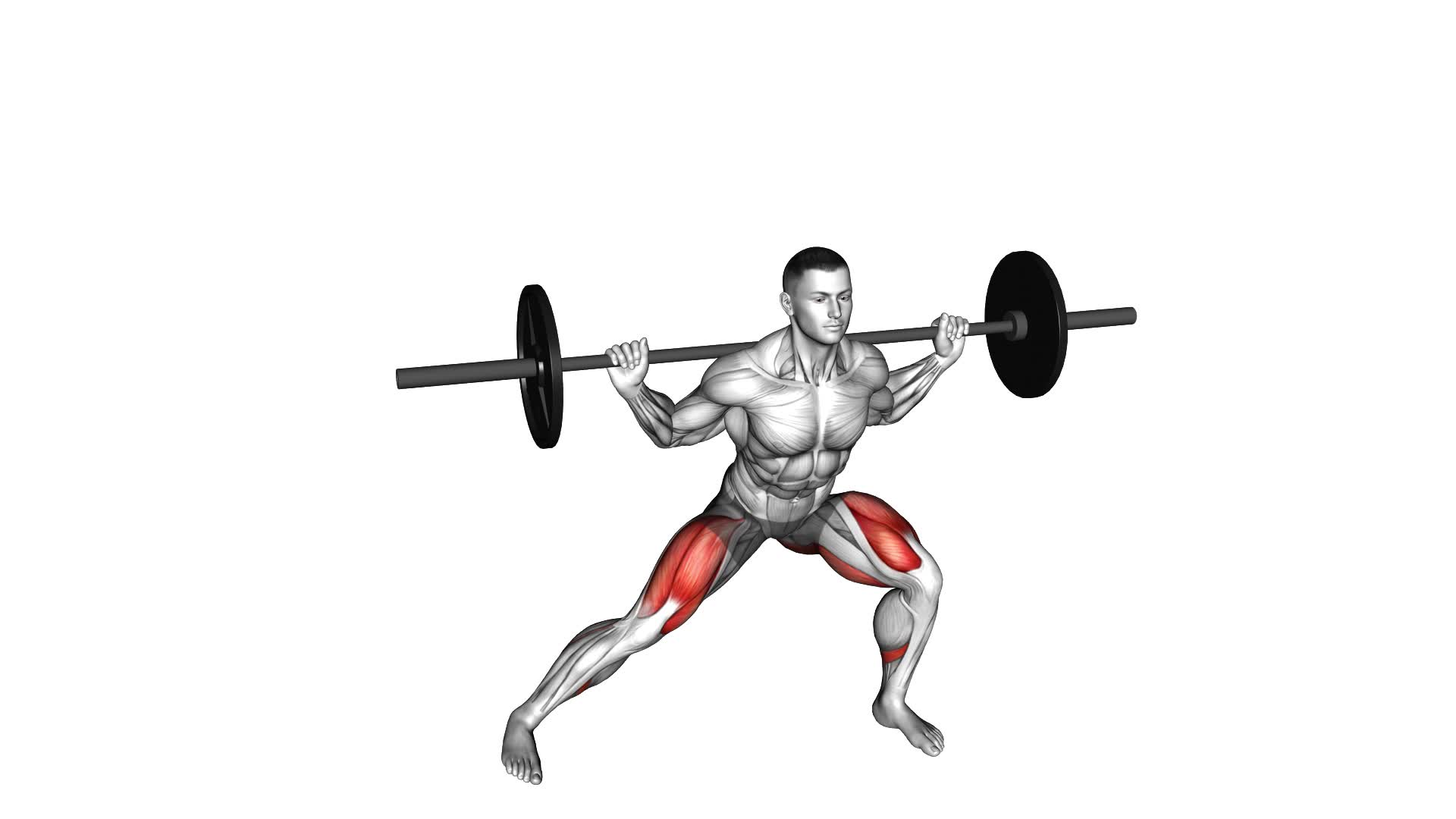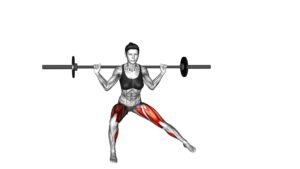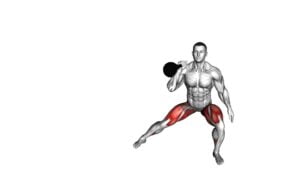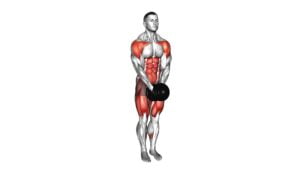Barbell Lateral Lunge – Video Exercise Guide & Tips

Looking to tone your legs and improve your lower body strength? Then the barbell lateral lunge is the perfect exercise for you!
Watch This Exercise Video
In this video exercise guide, we'll show you the proper form and technique to maximize your results. Plus, we'll share some tips to help you enhance your barbell lateral lunge and avoid common mistakes.
Get ready to take your leg workout to the next level with this effective exercise.
Key Takeaways
- The barbell lateral lunge improves lower body strength and stability.
- Engaging the core throughout the movement enhances balance and core engagement.
- This exercise targets the quadriceps, hamstrings, glutes, and adductors.
- Gradually increasing weight and maintaining proper form can help build muscle and improve overall lower body strength.
Benefits of the Barbell Lateral Lunge
The Barbell Lateral Lunge offers a range of benefits for improving lower body strength and stability. By incorporating this exercise into your routine, you can work on improving your balance and increasing your leg strength.
Balance is a crucial component of overall fitness, and the Barbell Lateral Lunge can help you enhance it. As you perform this exercise, you engage the muscles in your legs and core to maintain stability. This not only improves your ability to stay upright during the movement but also carries over to other activities in your daily life.
In addition to balance, the Barbell Lateral Lunge is an excellent exercise for increasing leg strength. As you step to the side and lower into the lunge position, your quads, hamstrings, and glutes are activated. This helps to build muscle and improve overall lower body strength.
To reap the benefits of the Barbell Lateral Lunge, you don't need much equipment. All you need is a barbell and some weights to load it, making it a convenient exercise that can be done at home or in the gym.
Equipment Needed for the Exercise
To perform the Barbell Lateral Lunge, you'll need a few pieces of equipment. The main equipment required for this exercise is a barbell. You can choose a barbell with a weight that suits your fitness level and goals. It's important to select a weight that challenges you but still allows you to maintain proper form throughout the exercise.
Additionally, you'll need weight plates to add to the barbell. These plates come in various sizes and weights, allowing you to adjust the intensity of the exercise as needed. Make sure the weight plates are securely fastened to the barbell before starting the exercise to avoid any accidents or injuries.
In terms of modifications, if you don't have access to a barbell, you can use dumbbells instead. Hold one dumbbell in each hand and perform the lateral lunges in the same manner. This modification can provide a similar level of challenge and engagement for your muscles.
Additionally, if you find the exercise too difficult, you can use a lighter weight or no weight at all until you build up your strength and stability. As you become more comfortable with the movement, you can gradually increase the weight to continue challenging yourself. Remember to always listen to your body and make modifications as necessary to ensure a safe and effective workout.
Proper Form and Technique for the Barbell Lateral Lunge
To ensure proper form and technique for the Barbell Lateral Lunge, focus on maintaining a stable grip on the barbell and engaging your core throughout the movement. This exercise targets several muscles, including the quadriceps, hamstrings, glutes, and adductors.
When performing the Barbell Lateral Lunge, start by standing with your feet shoulder-width apart and the barbell resting on your upper back. Take a step to the side with your right foot, keeping your toes pointed forward. As you step, lower your body by bending your right knee and pushing your hips back, while keeping your left leg straight. Make sure to maintain a neutral spine throughout the movement.
As you lower your body, keep your chest lifted and your weight centered over your right foot. Engage your core to maintain balance and stability. Push through your right heel to return to the starting position and repeat the movement on the other side.
It is important to note that there are variations of the Barbell Lateral Lunge that can be performed. Some variations include using dumbbells or kettlebells instead of a barbell, or adding a squat or a twist at the bottom of the lunge for added intensity.
Remember to start with a weight that allows you to maintain proper form and gradually increase the load as you become more comfortable with the exercise.
Tips to Enhance Your Barbell Lateral Lunge
To enhance your Barbell Lateral Lunge, focus on maintaining proper form and engaging your core throughout the movement. In addition to these foundational elements, there are a few tips that can help you maximize the effectiveness of this exercise.
Firstly, enhancing flexibility is key to performing a successful Barbell Lateral Lunge. Prior to starting your workout, make sure to warm up your muscles and stretch your hip flexors, hamstrings, and glutes. This will help you achieve a deeper lunge and prevent injury.
Secondly, consider incorporating variations of lateral lunges into your routine. By changing the angle or direction of your lunges, you can target different muscles and add variety to your workout. Some variations include diagonal lunges, curtsy lunges, or reverse lunges.
Lastly, pay attention to your breathing during the exercise. Inhale as you lower into the lunge and exhale as you push back up to the starting position. This will help you maintain control and stability throughout the movement.
Common Mistakes to Avoid During the Exercise
To avoid common mistakes during the Barbell Lateral Lunge exercise, focus on maintaining proper form and avoiding these key errors:
- Improper alignment:
- Make sure your feet are shoulder-width apart and your toes are pointing forward.
- Keep your chest up and your back straight to avoid putting unnecessary strain on your knees and lower back.
- Uneven weight distribution:
- When performing the lateral lunge, shift your weight onto the leg that's lunging out to the side.
- This will help you maintain balance and stability during the exercise.
- Lack of control:
- Perform the exercise slowly and deliberately, ensuring that you're engaging the correct muscles and maintaining proper form.
- This will help prevent injuries and maximize the effectiveness of the exercise.
Frequently Asked Questions
How Many Sets and Reps Should I Do for the Barbell Lateral Lunge?
To determine the number of sets and reps for the barbell lateral lunge, you should consider your fitness goals and current fitness level. Generally, it's recommended to perform 3-4 sets of 8-12 reps for this exercise. This will help improve strength, stability, and flexibility in your lower body.
The barbell lateral lunge targets your glutes, quadriceps, and hamstrings, and can also improve hip mobility. Remember to start with lighter weights and gradually increase as you get more comfortable with the exercise.
Can I Use Dumbbells Instead of a Barbell for This Exercise?
Yes, you can definitely use dumbbells as an alternative to a barbell for the lateral lunge exercise. Using dumbbells offers several benefits including increased stability and control, as well as the ability to work each leg independently.
This can help to improve balance and strength in your lower body. Just make sure to choose an appropriate weight and maintain proper form throughout the exercise.
Is the Barbell Lateral Lunge Suitable for Beginners?
Yes, the barbell lateral lunge is suitable for beginners. It provides numerous benefits such as improving lower body strength, stability, and flexibility.
To perform the exercise with proper form, start by standing with your feet shoulder-width apart and holding the barbell across your shoulders. Step to the side, bending your knee and lowering your body until your thigh is parallel to the ground. Push through your heel to return to the starting position.
Can the Barbell Lateral Lunge Help to Improve My Balance?
Yes, the barbell lateral lunge can definitely help improve your balance. By incorporating this exercise into your routine, you'll be targeting the muscles in your legs, hips, and core, which are all essential for stability.
Lateral lunges specifically work on lateral movement and strengthening the muscles responsible for side-to-side stability. This exercise also offers numerous benefits such as increased flexibility, improved hip mobility, and enhanced overall lower body strength.
Are There Any Modifications or Variations for the Barbell Lateral Lunge?
Looking for modifications or variations for the barbell lateral lunge?
There are several options to change up this exercise. You can try using dumbbells instead of a barbell, or even perform the movement without any weights at all.
Another variation is to add a twist at the bottom of the lunge, engaging your core even more.
Remember to always start with lighter weights and gradually increase as you get more comfortable with the exercise. Keep challenging yourself!
Conclusion
In conclusion, the barbell lateral lunge is a highly effective exercise for improving lower body strength and stability.
By adding resistance with a barbell, you can challenge your muscles even further. It's important to maintain proper form and technique to maximize the benefits and avoid injury.
Remember to start with a lighter weight and gradually increase as you become more comfortable. With consistent practice and attention to detail, you can enhance your barbell lateral lunge and achieve great results.

Author
Years ago, the spark of my life’s passion ignited in my mind the moment I stepped into the local gym for the first time. The inaugural bead of perspiration, the initial endeavor, the very first surge of endorphins, and a sense of pride that washed over me post-workout marked the beginning of my deep-seated interest in strength sports, fitness, and sports nutrition. This very curiosity blossomed rapidly into a profound fascination, propelling me to earn a Master’s degree in Physical Education from the Academy of Physical Education in Krakow, followed by a Sports Manager diploma from the Jagiellonian University. My journey of growth led me to gain more specialized qualifications, such as being a certified personal trainer with a focus on sports dietetics, a lifeguard, and an instructor for wellness and corrective gymnastics. Theoretical knowledge paired seamlessly with practical experience, reinforcing my belief that the transformation of individuals under my guidance was also a reflection of my personal growth. This belief holds true even today. Each day, I strive to push the boundaries and explore new realms. These realms gently elevate me to greater heights. The unique combination of passion for my field and the continuous quest for growth fuels my drive to break new ground.







